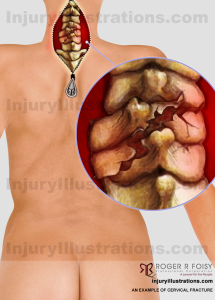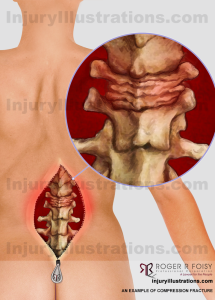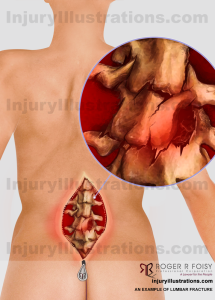Whether the result of a slip and fall, a serious motor vehicle accident, or another accident, a spine injury can be serious and have profound impacts on a person’s life. Often, the effects extend far beyond the physical injury itself and may have lasting influences on someone’s physical and psychological wellbeing.
In this article, I begin by highlighting six of the most common types of spine injuries before discussing the short and long-term impacts they can have and how these repercussions can affect a personal injury settlement.
Common Spine Injuries
 |
 |
 |
Cervical Fracture of the C5/C6Among some of the most devastating injuries, cervical fractures may occur in high-speed motor vehicle accidents with significant head or facial trauma. Cervical fractures to the C5/C6 may cause some or total paralysis of the wrists, hands, trunk, and legs.
Learn more about potential settlement values.
|
Back – Thoracic Compression Fracture – T9These fractures most often occur when the spinal column is subjected to forces that are greater than its strength and stability. Thoracic compression fractures are most often caused by falls from heights, motor vehicle accidents, and penetrating trauma. Common symptoms include: severe back pain, deformity of the spine (i.e. “hunchback”), and some pain relief when lying down.
Learn more about potential settlement values.
|
Back – Compression Fracture of the L1 VertebraeCompression fractures are generally the result of too much pressure on the vertebral body. Compression fractures can be caused by trauma to the spinal vertebrae from falls, jumps, or motor vehicle accidents. Common symptoms include: pain or numbness in the back, legs, and arms.
Learn more about potential settlement values.
|
 |
 |
 |
Back – Lumbar FractureA lumbar fracture is a fracture in the lower back, where the spine curves inward to the abdomen. Lumbar fractures can be caused by motor vehicle accidents, falls, and sports injuries. Common symptoms include: back pain, tingling, muscle spasms, bowel/bladder changes, and paralysis.
Learn more about potential settlement values.
|
Sacral FractureA sacral fracture is a break of the triangle-shaped bone found at the bottom of the spine. Sacral fractures can be caused by hard falls and motor vehicle accidents. Common symptoms include: lower back, buttock, or hip pain; pain in the front of the thigh and groin; bruising and swelling around the sacral area; and weakness of the lower limbs.
Learn more about potential settlement values.
|
Coccyx FractureA fracture of the coccyx is a fracture of what is commonly referred to as the tailbone. Fractures of the coccyx are often caused by falls onto a seated position or childbirth. Common symptoms include: pain and tenderness in the tailbone area, bruise, and straining and painful bowel movements.
Learn more about potential settlement values.
|
Recovering After a Spine Injury
 One of the challenges associated with injuries of the spine is that people often expect themselves to recover more quickly than they actually do. While the initial spine injury may heal in six to eight weeks, the road to complete recovery is often much longer or unfortunately never attained..
One of the challenges associated with injuries of the spine is that people often expect themselves to recover more quickly than they actually do. While the initial spine injury may heal in six to eight weeks, the road to complete recovery is often much longer or unfortunately never attained..
Beyond the nature of the physical injury itself, other factors that influence recovery include:
- Age: Typically, younger people are able to recover more rapidly than those who are older.
- Lifestyle: Personal circumstances such as needing to return to work or take care of young children may prevent someone from taking the time and space they need to fully recover; therefore prolonging or possibly preventing a full recovery.
- Location: Depending on where a person lives, they may struggle to find good care or may not be able to access it at all.
It’s important to recognize that, especially if the spine injury is the result of a severe motor vehicle accident, the harm may be so great that damage to the spine isn’t the only injury. Any additional injuries may further complicate or extend recovery and need to be taken into account when assessing how injuries have affected a person’s life and the type of supports they will need going forward.
The Long-Term Impacts of a Spine Injury
Chronic Pain
Chronic pain affects up to 70% of patients diagnosed with spine injuries[i] and can include both nociceptive and/or neuropathic pain:
- Nociceptive chronic pain is the more common of the two and includes visceral and musculoskeletal pain like throbbing bone aches, tense muscles, or headaches. It can develop as a response to the initial injury, due to muscle or joint overuse, or a combination of both.
- Neuropathic chronic pain occurs when nerves themselves are damaged. This type of chronic pain can be sporadic or constant and may feel shooting, burning, aching, or numbing. Ultimately, how it manifests varies between individuals.
Appropriate treatment for chronic pain may include medication as well as physiotherapy, psychological counselling, and other services.
Psychological Pain
A majority of people affected by a spine injury also suffer a degree of psychological harm. In some cases, it may be due to how the injury happened. Someone involved in a motor vehicle accident, for example, may find themselves becoming nervous or scared to drive afterwards. Other times psychological pain may be more related to the effects the injury has on someone’s life. If an individual’s injuries prevent them from socializing with friends and family, they could find themselves becoming depressed, while concerns about money could lead to feelings of anxiety.
Managing chronic pain can be a long and multi-disciplinary process. A person’s care team may include pain specialists, spine injury specialists, psychologists, physiotherapists, and other experts, all of whom work together to address physical and psychological sources of persistent pain.
Getting the Right Care Following a Spine Injury
In my experience, I have found that one of the best actions someone with an injury (spine or other) can take is involving an Occupational Therapist in their care early on. Occupational Therapists have a robust understanding of the body and its physical, psychological, and cognitive functions and are focused on identifying tools and strategies that can help patients return to their normal lives.

In assessing individual situations, Occupational Therapists consider holistic questions such as:
- Do a person’s living arrangements enable their recovery? If the home has stairs, for example, will that be a challenge?
- Are there any aids that would further a person’s recovery and rehabilitation like body pillows or an ice pick for a person’s cane?
- How is the individual doing psychologically and cognitively? Would they benefit from a referral to a specialist in pain, psychology, or another area of care?
Occupational Therapists can also help patients work through the concept of hurt versus harm in their day-to-day lives. After a spine injury, many people find that otherwise normal motions like lifting their arms while getting dressed can cause pain. Avoiding these movements altogether can sometimes lead to unintentional consequences down the road like muscle stiffness or fatigue.
This isn’t to say that all pain is good pain, and there are many situations where hurt either does mean or will lead to harm. By working with a rehabilitation specialist like an Occupational Therapist, an individual will be able to better understand their own limitations and learn exercises, activities, and modifications that will advance their recovery without adversely affecting them in the long term.
Working with an Occupational Therapist also benefits those seeking compensation for their injuries. When I recommend an Occupational Therapist to my clients, I get a report that provides me with a comprehensive breakdown of where my client was before the accident, where they ended up because of it, and where they have returned to since. This detailed information gives me the ability to precisely quantify my client’s claims and the damages they have sustained so I can clearly demonstrate how the injury has affected them.
To learn more about Occupational Therapists and the work they do, visit solutionsforliving.ca or function-ability.com. Both provide overviews of some key services as well as articles and other helpful resources.
Receiving the Settlement You Deserve
People often believe that settlement value is mostly determined by the extent of the injury. While this is a factor, the most important information is how the injury has impacted your life. In other words, what does the injury prevent you from being able to do and how does this affect you?
A thorough lawyer should take the time to fully understand your specific situation to ensure you do not under-settle your case. By quantifying every possible loss, you are more likely to receive a just settlement that will help to ease the financial burdens that usually occur during recovery.
If you have sustained a spine injury or other personal injury at another party’s fault, please do not hesitate to contact me and my team of experienced Ontario personal injury lawyers for a free consultation.
*Roger R. Foisy is not a medical professional. The advice in this blog is not meant to be a substitute for medical advice.
More on Personal Injury from Roger R. Foisy:
- How Mild Traumatic Brain Injuries (mTBIs) Affect the Family
- Social Media and Personal Injury Law: Can Social Media Affect Your Case?
- Recognizing the Signs and Symptoms of a Concussion
[i] Finnerup NB. Pain in patients with spinal cord injury. Pain 2013; 154 (Suppl. 1): S71-6.

